14.1 Cognitive Development
You know a lot of things. Two and two is four. Alaska is the largest U.S. state. George Washington was the first president. You also know how you know these facts: People taught them to you, and you committed them to memory. Now consider some other things you know:
If you take a ball of dough and flatten it out to make a pizza, you don’t have more dough after flattening it out than when you started.
If you paint white stripes on a black horse, you end up with a horse with white stripes, not a zebra.
If you move someone’s book from one location to another when that person isn’t looking, he or she will first look for the book in its original location, not its actual location, and will be surprised when it is not there.
How did you learn these things? It’s unlikely that a biology teacher ever taught you the one about horses and zebras, yet you know it is true. And when did you learn them? Were you born with such knowledge, or did you acquire it gradually during childhood? Questions like these are the focus of study in cognitive development.
603
The Psychology of Jean Piaget
Preview Questions
Question
 What were the key features of Piaget’s research method?
What were the key features of Piaget’s research method?
 What cognitive tools enable us to solve logical reasoning problems we’ve never encountered before?
What cognitive tools enable us to solve logical reasoning problems we’ve never encountered before?
 How does our existing knowledge enable us to adapt to the environment? Through what process do we update that knowledge?
How does our existing knowledge enable us to adapt to the environment? Through what process do we update that knowledge?
 What makes Piaget’s approach a nature and nurture one?
What makes Piaget’s approach a nature and nurture one?
 Which comes first: learning or development?
Which comes first: learning or development?
 What characterizes each of Piaget’s stages of cognitive development?
What characterizes each of Piaget’s stages of cognitive development?
Any review of cognitive development must begin with the monumental contributions of Jean Piaget, among the most influential figures in the history of psychology (Haggbloom et al., 2002). Piaget was trained as a biologist. But a job working with children aroused his interest in a psychological question: How do children’s thinking abilities develop? To find out, he studied young children (including his own) from the 1920s until his death in 1980.
Piaget achieved scientific breakthroughs that were not appreciated immediately. However, English-

PIAGET’S METHOD. Piaget devised a research method that was simple yet powerful. It had two key features (Flavell, 1963):
Ask children to solve problems that are novel: Rather than asking children to recall facts they had already learned, Piaget asked them to solve problems they had never seen before. This enabled him to study the developing mind in action, as it tackles new challenges. For example, in a classic problem (discussed in detail below), Piaget poured water from a wide container into a tall, narrow one and asked children a novel question: During this process, did the total amount of water change or remain the same?
At what age do you suppose children are able to correctly solve this problem?
Ask children about their answers: Rather than merely recording the correctness of children’s answers, Piaget asked them to explain why they chose those answers. This simple step provided more insight into the developing mind.
SCHEMAS AND OPERATIONS. How can children solve problems they have never seen before? Piaget’s answer is simple. Anything a person does—
Piaget called these mental structures schemas. A schema, in Piagetian theory, is a mental structure that makes organized, meaningful action possible. A schema for grasping enables an infant to grab hold of a variety of toys. A schema for dogs enables a child to point to a picture of a dog in a book when asked to do so. A schema for proportions (i.e., relations between two amounts; Boulanger, 1976) enables an older child to figure out that a car that takes 15 minutes to travel 2 miles is faster than a car that takes 10 minutes to travel 1 mile. Once in possession of the schemas, children can grasp toys, identify dogs, and solve proportion problems that they have never come across before.
604
Schemas enable children to engage in operations (Piaget, 1964), which are actions that modify an object or set of objects. The modification can be physical (e.g., arranging objects from smallest to largest) or conceptual (e.g., placing words in alphabetical order). Operations are reversible; the logical system used in the operation can go in two directions (objects can be ordered from largest to smallest or placed in reverse alphabetical order). Operations, to Piaget, are “the essence of knowledge” (1964, p. 20). Knowledge therefore consists of not merely facts, but the ability to do things: to conduct operations using schemas.
CONNECTING TO PROBLEM SOLVING AND BRAIN NETWORKS

ASSIMILATION AND ACCOMMODATION. People use their schemas to adapt to the environment. Piaget’s theory highlights two processes of adaption: assimilation and accommodation.
In assimilation, external events are incorporated into an existing schema; children think about events and act on objects in ways that reflect the schemas they possess. If a child with a grasping schema used previously on toys grasps an adult’s eyeglasses, she is assimilating eyeglasses to her grasping schema. If a child with a schema for chickens sees a Thanksgiving turkey and says, “Cluck, cluck, chicken,” he is assimilating the turkey to his chicken schema.
Accommodation is the modification of schemas as a result of environmental feedback. In accommodation, schemas change. If, in the preceding example, adults explain that “no, it’s a turkey, not a chicken,” the child will eventually accommodate to the environment by dividing his original one schema into two: a chicken schema and a turkey schema. Experience, then, increases the number and precision of children’s schemas.
Piaget’s theory of schemas, assimilation, and accommodation addresses two questions of interest to all psychologists. The first is the nature–
The second question is the relation between learning and development. In some other psychological theories, “development” refers merely to changes in behavior that result from learning (see Chapter 7). Learning, in this view, drives development. But Piaget thought this was backward; he believed that development—
605
STAGES OF DEVELOPMENT. Piaget claimed that cognitive development occurs in a fixed series of steps, or stages. A developmental stage is a period of time (months or years) during which one form of thinking is predominant. In a stage theory of development, the child is said to maintain one level of development for a given time period, and then to transition relatively rapidly to a new, higher level. Metaphorically, development is like a flight of stairs rather than a ramp: There are discrete steps, traversed in a fixed order.
I think that development explains learning, and this opinion is contrary to the widely held opinion that development is a sum of discrete learning experiences. … Development is the essential process and each element of learning occurs as a function of total development.
—Piaget (1964, p. 20)
Piaget proposed four stages of development: the (1) sensorimotor, (2) preoperational, (3) concrete operational, and (4) formal operational stages (Table 14.1).
14.1
| Piagetian Stages | ||
|---|---|---|
|
Stage |
Age |
Description |
|
Sensorimotor |
Birth to 2 years |
Child’s interactions with the environment are based on sensory and motor systems; no logical operations occur. |
|
Preoperational |
2 to 7 years |
Child can use mental symbols (words, numbers), yet still cannot perform logical operations. |
|
Concrete operational |
7 to 11 years |
Child can perform logical operations on physical (“concrete”) objects. |
|
Formal operational |
11 years to adulthood |
Child can perform operations on physical and hypothetical objects; he or she can also engage in abstract reasoning. |
In the sensorimotor stage (birth to 2 years), the child interacts with the world through his or her sensory systems (e.g., hearing, vision) and systems for motor movement (e.g., sucking, grasping). Children at this stage are preverbal; they cannot think in words. Although they cannot formulate a thought such as “I’d like to play with my new toy,” they can see the new toy and play with it. Schemas involving sensation and motor movement enable purposeful action.
During the sensorimotor stage, children develop a concept you normally take for granted: object permanence. Object permanence is the understanding that objects continue to exist even when they can no longer be seen or otherwise perceived. Early in the sensorimotor stage, infants lack this capacity. If they are playing with a toy and an adult covers it with a piece of cloth, they will be baffled and won’t look under the cloth for the toy. Later in the sensorimotor stage, they will. The child must develop a conception that the object still exists, despite being out of sight.
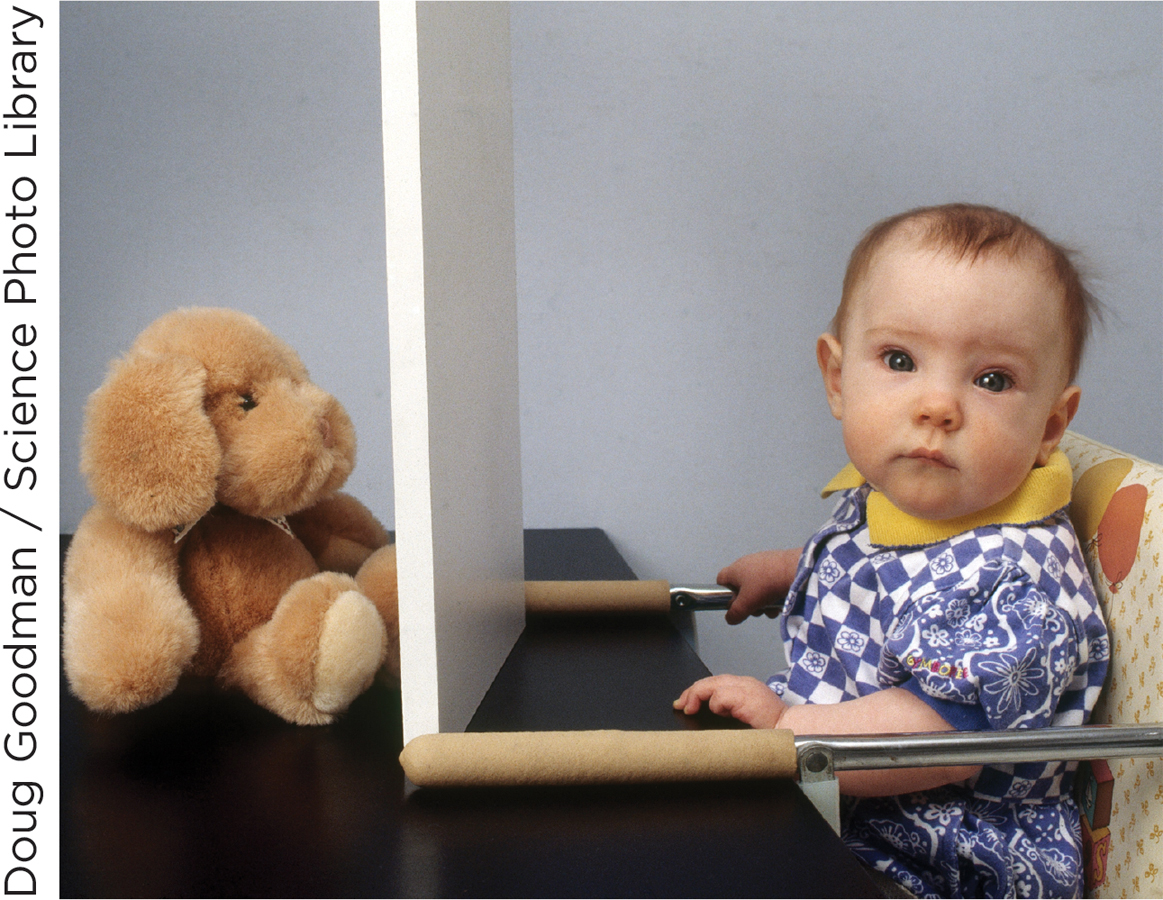
Do you suppose the “peek-
In the preoperational stage of development (ages 2 to 7), children can use mental symbols—
606
Conservation, in Piagetian psychology, is the recognition that an object maintains some essential physical properties even when it is physically transformed. In other words, those properties are conserved. Suppose you spread a ball of dough into a flat pizza. If you recognize that this spreading does not give you any more (or less) dough, then you have exhibited conservation; you know the dough’s mass is conserved in spite of the transformation of its shape. Conservation requires a reversible mental operation. You must be able to see that going back and forth—
Piaget discovered that, in the preoperational stage, children are not capable of conservation. They cannot perform the reversible mental operations needed to understand that physical properties are conserved. In a classic demonstration, Piaget poured water from a short, wide beaker into a tall, narrow one and asked children whether the amount of water was the same or different (Figure 14.1). “Different,” they said! Children in the preoperational stage use a simple physical cue, the height of the water, to judge how much water there is; they thus believe more water is present when the liquid is poured into the narrow beaker.

In the concrete operational stage of development (ages 7 to 11), the child can perform reversible logical operations. Many of these operations have the same structure as basic arithmetic: adding and subtracting; judging that amounts are greater or lesser than one another; dividing groups into subgroups of items. If shown a group of six cats and two dogs and asked if there are more animals than there are cats, the child in the concrete operational stage can solve the problem; that child recognizes that cats are a subgroup of a larger group, animals. In earlier stages, however, children cannot perform this mental operation and are likely to say that there are more cats. Thanks to the ability to perform reversible operations, children in the concrete operational stage of development can begin to solve the conservation problems described earlier.
A mental limitation in the concrete operational stage is that children can execute operations only on objects, that is, things that actually exist in the child’s experience. In the formal operational stage (age 11 through adulthood), they can execute operations on both actual objects and hypothetical ones. Questions about blue unicorns and flying dogs (e.g., if there are six blue unicorns and two flying dogs, are there more animals than dogs?) can be contemplated logically, even though the objects do not exist. The child thinks about hypothetical objects by applying abstract rules. For example, if asked to think of a number that has the following property—

607
THINK ABOUT IT
Piaget studied a relatively small number of children living in Europe in the mid-
Piaget recognized that children reach the stages at different ages; diverse experiences might accelerate or slow development. However, he claimed that the stages occur in a fixed order. You can’t skip any. The ordering reflects the logical relation among stages. To engage in concrete operational thinking, you first have to be able to think using symbols (the achievement of preoperational thought). To engage in formal operational thinking, you first have to be able to think using operations (the achievement of concrete operational thought).
WHAT DO YOU KNOW?…
Question 1
Bette had grasped conservation and therefore was able to judge that pouring the water from the wide pitcher to the tall pitcher did not increase the volume of the water.
- euojutK5xOADozMsM77fQz0uVMypf4oM9MQ1xKnZpnqfNgtXYa9sY6T8zWQoqHVxWjOby6APmNi5yQZ0PUmu8QbgKfjHkBgMxBmzFv+V3Zj5jMVl
- 0wQlGe3ANB5vL50iRp1aW1emPNj+O4CDyf7n3KXYWFzWaNix0Yk/fYZ6AcSUsd2hF/iz4KeWTQ4opc0fcuKEtcbE8Zbe1EcAOkm7u5Fe6gk=
a. The schema is conservation, and the operation is the judgment that the volume of the water did not change when moved from one pitcher to another. b. This is an example of assimilation because her conservation schema enables her to correctly judge that the volume of the water does not change; she does not have to modify her existing schema, as is the case in accommodation.
Question 2
eAlsYlTzDxxJnfJcsqOa0vAIeW1UIDnVwY6U1WS0IFg0+aiq3Zi3dtKR0iCREeH6tlRIm/sQpA7wBchYD+48+bwbWlxAZ9y6bygo3NxbH4x882zPLdez1MgqilsQiTrCHu7/a642nbes9w0x4LdzYq8euIWALKNOcIotoF4ySLF9n743HLCsiVSjrOGJyQCGDz2OTYwXTdLJFIXJwdbvdlvuTYTALLe2dJ34Pw1fnG5x11k+ZZ26wdSEH+nFShdpmVcRuuvkZe+OgVlXK8RQaN0IzxuexgyvYUh+GZNxpBYP/d0US6FGHCVsEVd7TyWp01+Rx2V06C4mJ+3veZpOH2bRzlke7lHwf8J880/Kuj4fNhZ00bYW9TqiGALLO2eNqZmegEwoSDoI3PVEQuestion 3
Match the Piagetian stage on the left with the characteristics on the right. There are one to three characteristics listed for each stage.
1. Sensorimotor |
a. Reversible logical operations such as conservation are first possible. |
2. Preoperational |
b. Ability to think using words emerges. |
3. Concrete operational |
c. Child can execute operations on concrete and hypothetical objects. |
4. Formal operational |
d. Interaction with the world occurs, in large part, by sucking and grasping. |
e. Child can execute operations, but only on objects. |
|
f. Reversible logical operations such as dividing groups into subgroups are first possible. |
|
g. The child can think about hypothetical situations by applying abstract rules. |
|
h. Children cannot think in words; that is, they are preverbal. |
|
i. Object permanence develops. |
Answer: 1dhi, 2b, 3aef, 4gc
608
Domain-Linked Cognitive Development
Preview Question
Question
 In what domains of thinking are children actually smarter than Piaget had predicted?
In what domains of thinking are children actually smarter than Piaget had predicted?
Piaget’s contributions are of unparalleled importance. Yet developmental psychology has moved beyond his contributions. Contemporary research suggests that Piaget overlooked a factor critical to children’s cognitive development: domains.
In the study of cognition, a domain is an area of knowledge and mental ability (Hirschfeld & Gelman, 1994). For example, knowledge about plants (e.g., that they grow, need water, and are not manmade) and about household objects (e.g., that they do not grow or need watering and are manmade) would be two separate domains. The ability to use language (see Chapter 8) or to appreciate and produce music (Justus & Hutsler, 2005) similarly may be distinct domains.
Piaget’s theory was domain-
Research challenges this expectation of Piagetian theory. In particular domains of thinking, children seem “smarter”—that is, engage in more complex thinking processes—
OBJECTS. Piaget found that, in infancy, children lack object permanence. They seem to have no understanding that there is such a thing as an object with a permanent, fixed existence. Recent research, however, reveals that they understand more than Piaget had thought. Much of this modern research uses a valuable research tool that was not employed by Piaget: looking-
RESEARCH TOOLKIT
Looking-Time Methods
Imagine that you show people an empty box, place a ball in it, place another ball in it, and want to know how many balls they then expect are in the box. How would you find out? Just ask them. They will say they expect two. Similarly, if people see a toy car rolling along a floor and you want to find out what they expect will happen when it reaches a wall, you can ask them. They will say they expect it will hit the wall and stop. Their expectations reveal their knowledge. The people know that 1 plus 1 is 2 and that walls are solid.
But what if the people are infants? How could you find out what they know? Infants can’t state their expectations. But that doesn’t mean they don’t have any. Infants might have sophisticated expectations about events while lacking the ability to put those expectations into words. To learn about infants’ knowledge, researchers thus need a measuring tool that does not require language.
One such tool is looking-
Knowledge guides expectations. For example, because we know that walls are solid, we expect toy cars to stop rolling when they reach them.
Expectations influence gaze. People generally look longer at events that are unexpected; unexpected events “catch the eye” of observers.
609

Researchers infer that if babies look longer at one event than another, then, all other things being equal, the babies must have been surprised by that event. The event must, in other words, have violated their expectations.
Many studies have used looking-
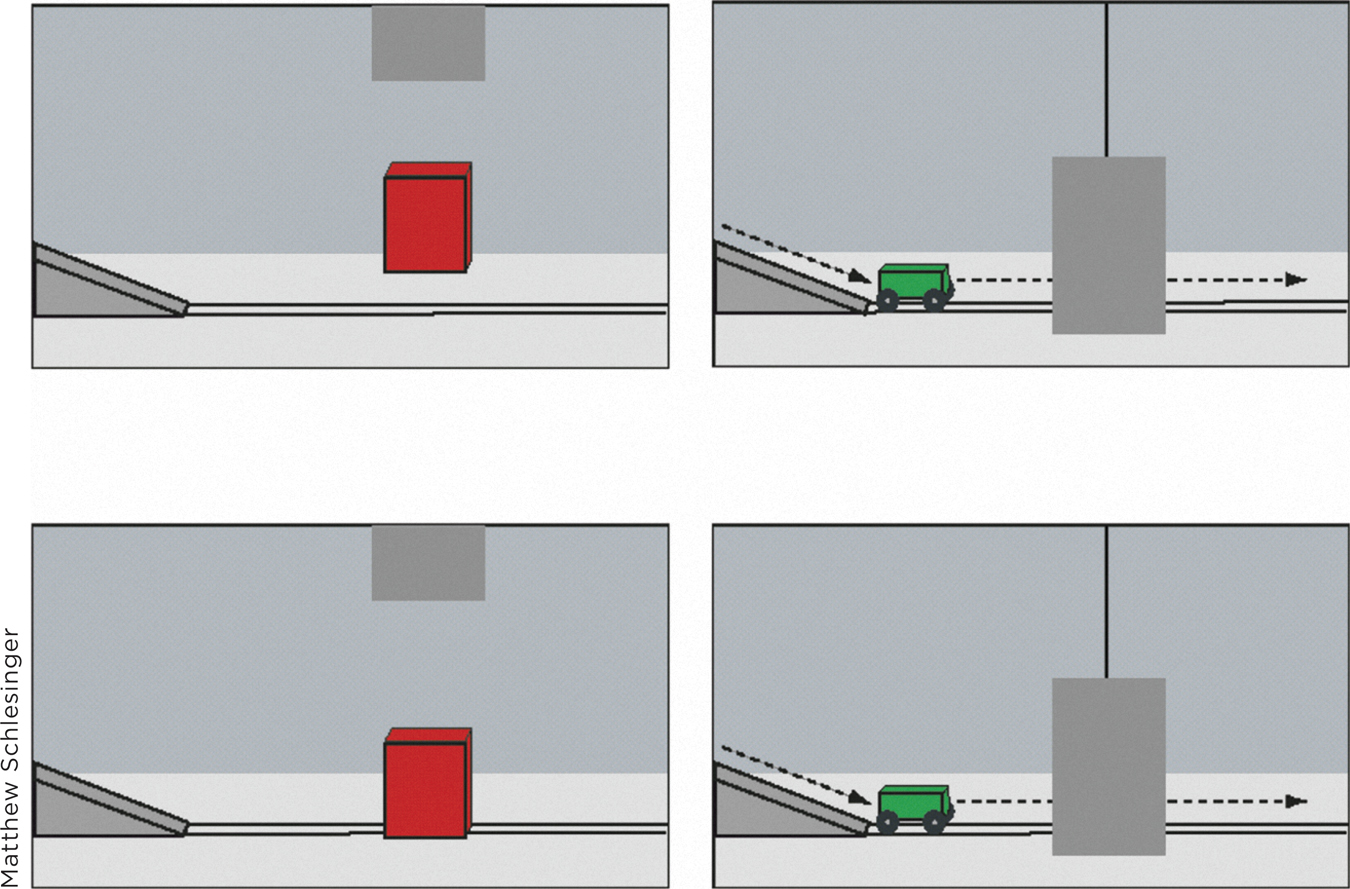
Other looking-
In sum, infants know a lot more than they can say, and looking-
WHAT DO YOU KNOW?…
Question 4
5nFtrkuBHayjKLSICV9TZyZJUua5WjbrmzKvIAsXWf4AJoXOx2+A6fnDCvPpCFloPJPyPmCUiUD3ykNY4iomJ/fC/j2RotE2Om+2WOLdGSyHLnfcuE+5HVgpPM8icO+aagIsZYl+PePN4tT4oPYP+bhENzCEj8KQZmf4fpxx3F9sCxJEJ+EX/DJsapdo0YPh+FVU3J1qiNT4KivteVzptYtb/0lswJJ3Z4niBr1l7HkX8r0E+HUFRlFX0YmtSuy6Z/MDaH6inzjxl/ZL7BQHIptcVqHcTQyvpUXkguTgmT+ajbyxe6nzJvE1MHUXg4M9jcUSLPLVrQKQTOiDEbctSYBxLHl3RrvszcZ9EyWHqYvsqooAiQxIXdR3Kt7YRzR4PVgJkwDgAq1vvCCgnmLBRr+Rlfxn1vY7GVXHZYuIuOB4WUtmQEpupkuA+v3E7g9sUaWRqqDAkUmz7JOt4xRzXJU9sFt/bvPMsGghTXmHMkg=610
As the developmental psychologist Paul Bloom (2004) reviews, results of looking-
They pull on one piece of an object and, instead of the whole object moving toward them, a piece comes off.
An object moving from left to right passes behind one of two barriers (on the left) and then reappears from behind the other barrier (on the right) without being seen passing between the two barriers.
An object is placed on a table behind a solid screen, and then the screen tilts back and lands on the table without hitting the object.
One object moves toward another, on a path to hit it, but the second object moves before the first one hits it.
Their surprise indicates that they held expectations. The infants expected that objects were coherent wholes (not a collection of pieces that would break off); that they moved continuously (and thus couldn’t jump from one barrier to another); and that they had a permanent existence, were solid, and could not move spontaneously. The infants could not put their knowledge into words. Nevertheless, their expectations reveal that they possessed knowledge of objects, despite being in the Piagetian sensorimotor period.
LIVING THINGS. A second domain about which young children display surprising amounts of knowledge is livings things. Piaget expected that children younger than school age would not be able to form the abstract mental category “living things” and thus would not recognize, for example, that their baby sister is alive, needs food, and sleeps, whereas their baby doll does not. Again, however, more recent evidence reveals that Piaget underestimated young children’s knowledge. As Wellman and Gelman (1992) review:
Three-
year- olds distinguish between inanimate objects and animate livings things (i.e., animals, but not plants). They know that animals have feelings and that rocks, for example, do not. When 12-
month- olds are shown a series of toy animals and then either another toy animal or a toy boat, they are surprised (as measured by how long they look) if the object presented was the boat. This means they recognize the distinction between the categories “animals” and “inanimate objects.” Children’s ability to distinguish inanimate objects from living things is not based merely on the superficial appearance of the items. If shown a realistic-
looking mechanical animal, children do not think it needs to sleep or can have babies.
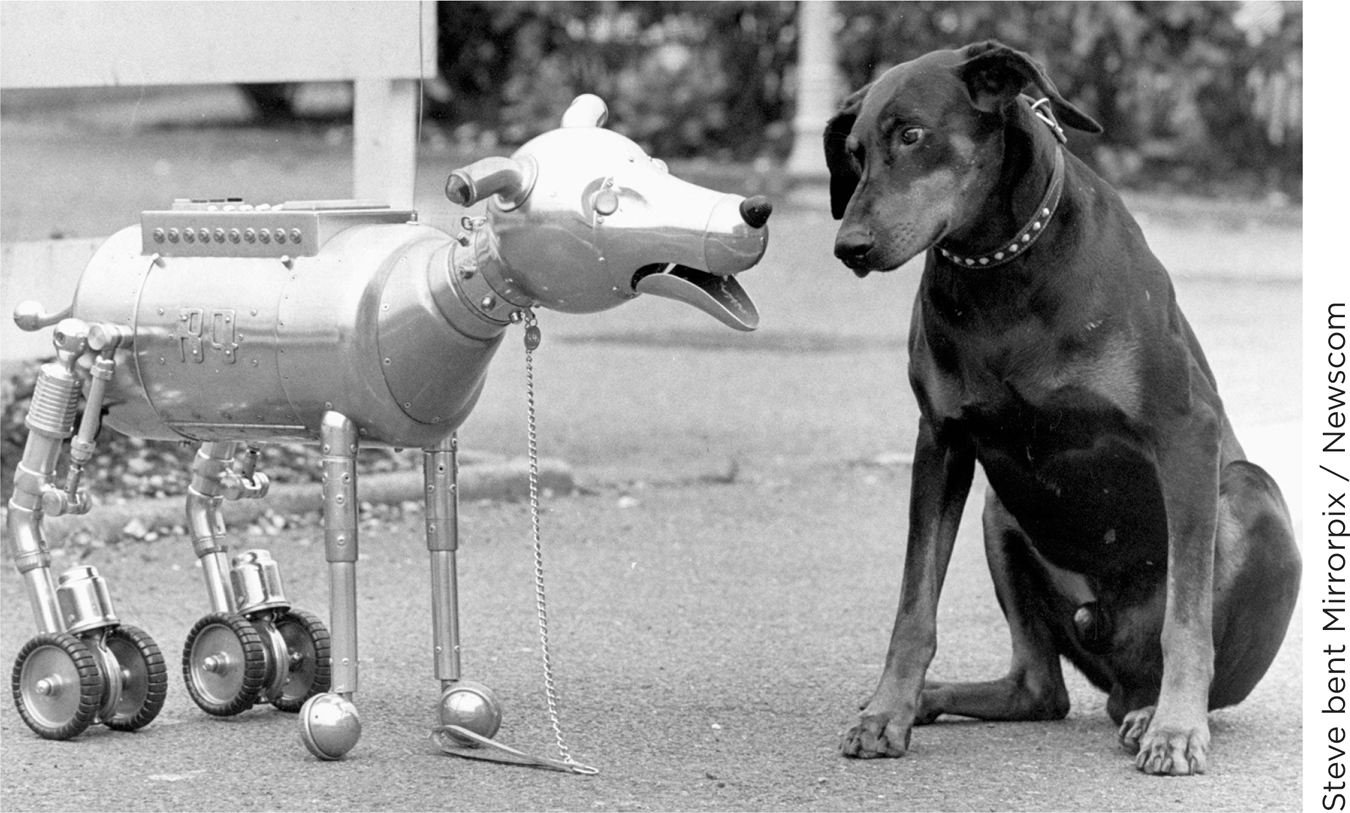
611
PEOPLE AND THEIR MINDS. Children also display more knowledge than Piaget expected when they think about the human mind. Even at a young age, children know that the people they encounter have minds, and that the plants and toys they encounter do not. Children possess a theory of mind, an understanding that other people have feelings and thoughts (Wellman, Cross, & Watson, 2001).
Evidence of theory of mind comes from a cleverly designed experimental task (Wimmer & Perner, 1983). Children of varying ages are shown a series of pictures: Someone places an object in one location and then leaves the vicinity (Figure 14.3). While the first person is away, a second person moves the object to a different location. Children are asked to indicate where the first person will look for the item when she returns. Yes, it’s easy for you—
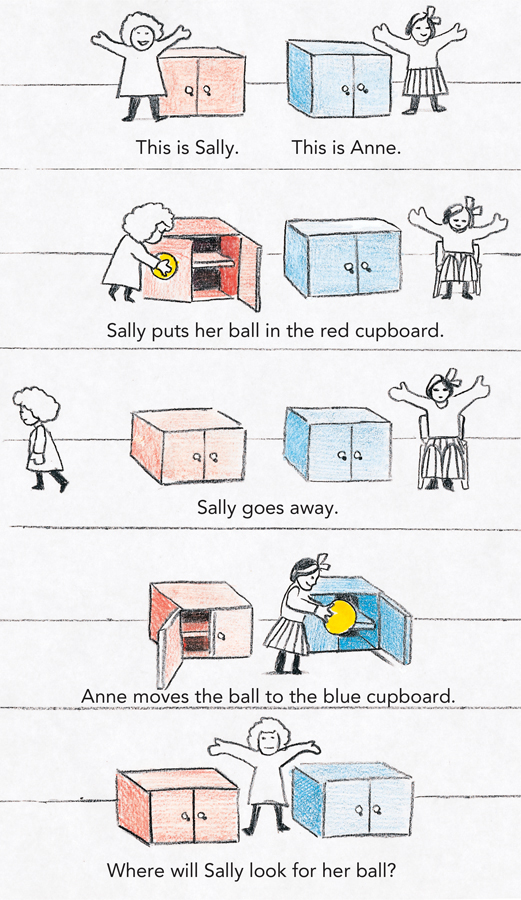
Ability to perform this task correctly develops during the preschool years (Wellman et al., 2001; Wimmer & Perner, 1983). At age 3, children cannot get it right; they think that, upon returning, the person will look for the object in its actual, new location. By age 6, more than half of children get the problem correct, and by age 8 to 9, the vast majority of children answer it correctly.
Other research shows that substantial elements of a theory of mind are in place even earlier (Wellman & Gelman, 1992). If asked why someone is looking in a particular location for an object, 4-
Many researchers suggest that theory of mind is central to a disorder of psychological development, autism. More formally known as autism spectrum disorder, autism refers to a range of symptoms whose central features include impaired communication and social interaction with other people (National Institute of Mental Health, 2011). Children with autism might, for instance, focus their attention on objects while failing to establish eye contact with other people. Children who lack a theory of mind, and thus fail to understand that others have feelings and thoughts, may be those who experience symptoms of autism (Baron-
WHAT DO YOU KNOW?…
Question 5
True or False?
- 8VFubEONu0eoQLYwpYk0+3uYvPs+6obANgWW2xcTpzRbpUs/S0riN4ByDlvDmQ7dts2mXfUDeyiDGnFGRJAIQamZ5ra3vPjYjedSlqu7S3niZT2pXWNJKo73/b5u2xXDoj7HuJ7Yp8i2J+9cnmsSyRUJpJcbz+tc7jZd/UzCkhDJErJcCmO1N1PTph9eococQ4F0eq4owzR0RoKIvuFF6m9etoe15Een5Z4iIToG8+YirCLYLedSZArkBBn0oZsvoNpPzYYPvO+dEydQSmcfyE8wdb1EKIZ/hl1kNgpe4hNG6okWp4pKdw==
- UiaJMmLOQSPsUm1YmkVydeZDve41EmRDgWRlcaNXR24OTZgLX9/h8j615ku1xrsHl+oWNV1l6Tyt5vwsWnfzD2LL7+voIwUAo9FXH3aC/nmlBMzjCA0ScQ9uYmxnhNExM2Aqa6HYrk6/aY6sywdLRf8tMFPUec50FKsc6ylE06Ebb9PPb5p9ViE02+Q=
- FAqan3YE1ncrJ/X0Rhut9foaOLf0Lh0YSlI29n8K3n8+fbJVM1OzxhRBcxyg8jx+23tw8wsempxGnSf1ltlkAqOXx1HEh4jsAwHrLVSLIFLxHYQibVY/pMPLo/J0wPIfCtC7g6kFEta0EOkJqMi53OrKzPKmqK8/qtf/9eUYsFJ6Ef+Ndjh41wrtkiDZyMVQEic9gg==
Alternatives to Piagetian Theory
Preview Questions
Question
 Are children born knowing things?
Are children born knowing things?
 How do children’s social interactions influence their development?
How do children’s social interactions influence their development?
 To aid development, is it a good idea to challenge children with problems that are above their current abilities?
To aid development, is it a good idea to challenge children with problems that are above their current abilities?
612
Novel research findings prompt psychologists to develop novel theories. Let’s consider two attempts to move beyond Piagetian theory. The first proposes the existence of innate mental structures.
INNATE MENTAL STRUCTURES. As you’ve seen, children possess domain-
Research on domain-
One theory of innate mental structures has been developed by Harvard psychologist Susan Carey (2009, 2011). She proposes that children possess innate input analyzers, that is, biologically inherited mental mechanisms designed to detect and process specific types of information. The type of information corresponds to the domains of knowledge we have just reviewed. For example, an innate input analyzer that detects agents (entities that have goals and pursue them through their actions) contributes to children’s ability to distinguish animate living things from objects as well as to their development of a theory of mind.
SOCIAL AND CULTURAL EXPERIENCE. A second alternative to Piagetian theory is grounded in the work of Lev Vygotsky, a Russian psychologist living in the first third of the twentieth century (Daniels, Cole, & Wertsch, 2007). Vygotsky believed that Piaget underestimated the importance of social and cultural experience and provided a theory of cognitive development that put sociocultural factors in their proper place.
In Piagetian theory, development primarily is an individual process. The lone child encounters the world, puzzles through various experiences, and thus advances in logical thinking. But Vygotsky notes that much development occurs through social interaction. Children acquire the cognitive tools of their culture—
Once children have practice using cultural tools, they internalize them (Vygotsky, 1978). What first was a social activity becomes a feature of the child’s inner mental life. Consider language. At first, it is a way to communicate with others. But once learned, it dominates inner thoughts; people “talk to themselves” in sentences and internal dialogues (Hermans, 1996). This inner speech serves important functions. Children gain control over their behavior by listening to instructions (e.g., “Timmie, don’t touch the stove”) and internalizing them (“I must not touch the stove”; see Meichenbaum, 1977).
Are you ever aware of your own inner dialogue?
Unlike Piaget, Vygotsky (1978) thought that children, at any given time, should be characterized at two developmental levels: their current level of cognitive development and their potential level. Potential levels are mental achievements children cannot reach by themselves, but that they can reach through interacting with others who support them (e.g., with hints, examples, or leading questions). Vygotsky called the region between the two levels the zone of proximal development. This zone, then, contains problems the child cannot do independently, yet can do collaboratively (Figure 14.4). Vygotsky encouraged educators to challenge learners with problems in their zone of proximal development. Doing so, he said, would speed learning and psychological development.
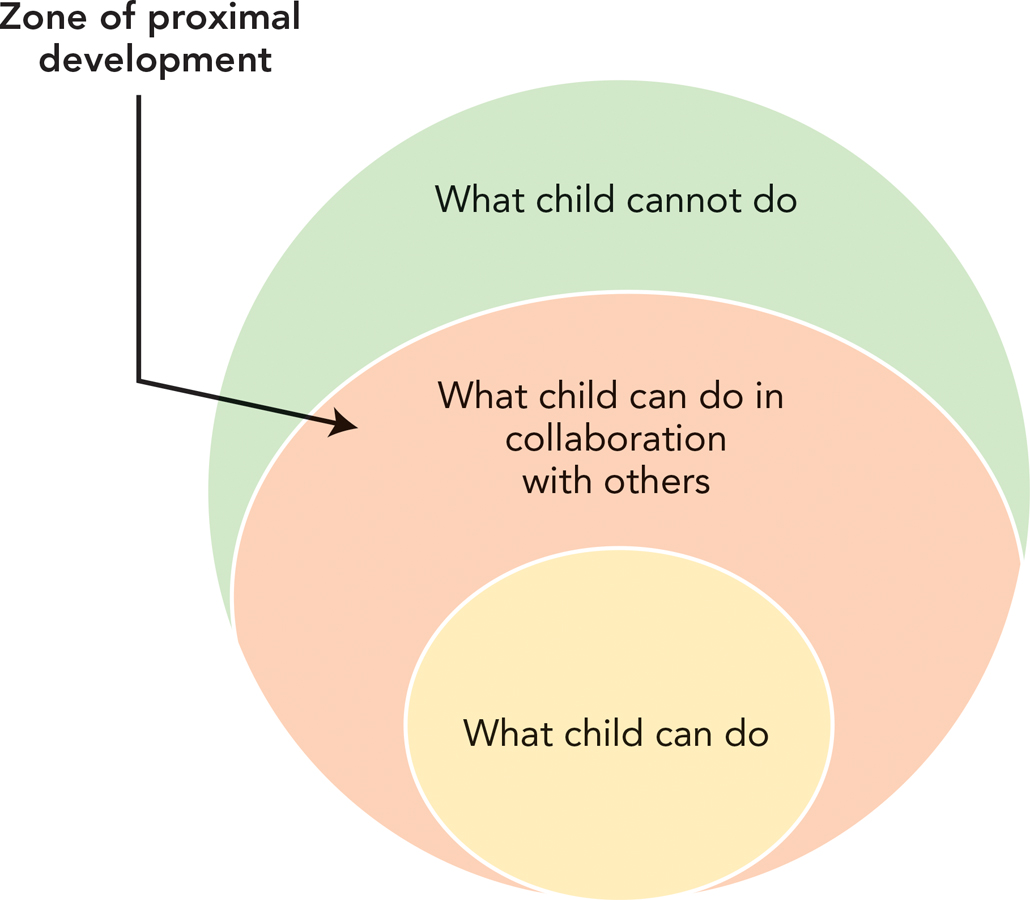

613
Children often learn through zone-
In summary, Vygotsky showed how the development of the mind is enhanced by the social experiences of the person. In so doing, he uncovered key connections between person and mind, and between social and cognitive development.
WHAT DO YOU KNOW?…
Question 6
- SqMyoyKianZTiwyifVXYF7FsIHVXuWJPRLsx4xBtGlKFks7Ag3DQs7wgpExm4KbgSVUvjFLgV7+agCdN+e+el6NzoU7SB1Mtwm4fnee+LPxdVqubcyLEBZ/U/nX/x/sBCszjpO/SbJ8=
- cs5xeeAeWSaZuNgBeBMImlFKG6OMCwnGab/z1/4VDsSASX9PSr4qmUYeXtovpB4cGtd16ADwWzCS50nt7ndwm2jsvSAo+bB56ID2j/+ZVueFJ7t1WdPm/h7R58VBkuhlciLL/jSXoORG8wudWZejbPDEXVY=
a. Susan Carey challenged Piaget’s claim that children learn entirely through experience when she theorized that children possess innate input analyzers, mental mechanisms that detect and process specific types of information. b. Lev Vygotsky challenged Piaget’s claim that children learn alone when he theorized that there exists a zone of proximal development, a gap between a child’s current and potential level of development consisting of problems the child cannot do alone but can complete in collaboration with others.
Cognitive Development and the Brain
Preview Questions
Question
 Does being raised in a more enriched environment increase brain size?
Does being raised in a more enriched environment increase brain size?
 Does the brain’s development actually map onto Piaget’s stages of cognitive development?
Does the brain’s development actually map onto Piaget’s stages of cognitive development?
 How does the brain’s connectivity change across the life span?
How does the brain’s connectivity change across the life span?
614
You have learned that social experience spurs cognitive development. This psychological fact leads to a biological prediction: Environmental experience also should spur the biological development in the brain because the brain is the organ of cognition. Let’s now move to a biological level of analysis to see if this prediction holds true.
ENVIRONMENTAL ENRICHMENT AND BRAIN DEVELOPMENT. How could you find out whether environmental experience enhances brain development? Ideally, you would run an experiment: Raise individuals in different environments and then measure their brains. The experiment, unethical with humans, has been conducted with animals.
Researchers (e.g., Jurgens & Johnson, 2012) have raised mice in environments that vary in enrichment, that is, the degree to which the environment contains complex physical stimuli (tunnels, ladders) and social stimuli (other mice). After a period of development, the brains of these mice are compared with others who are raised in a low-
The cerebral cortex (the outer layer of the brain) is thicker.
Individual brain cells form more connections with other cells.
Brain cells are covered by more myelin, an insulating material that speeds nervous system communications.
Blood vessels in the brain are more fully developed.
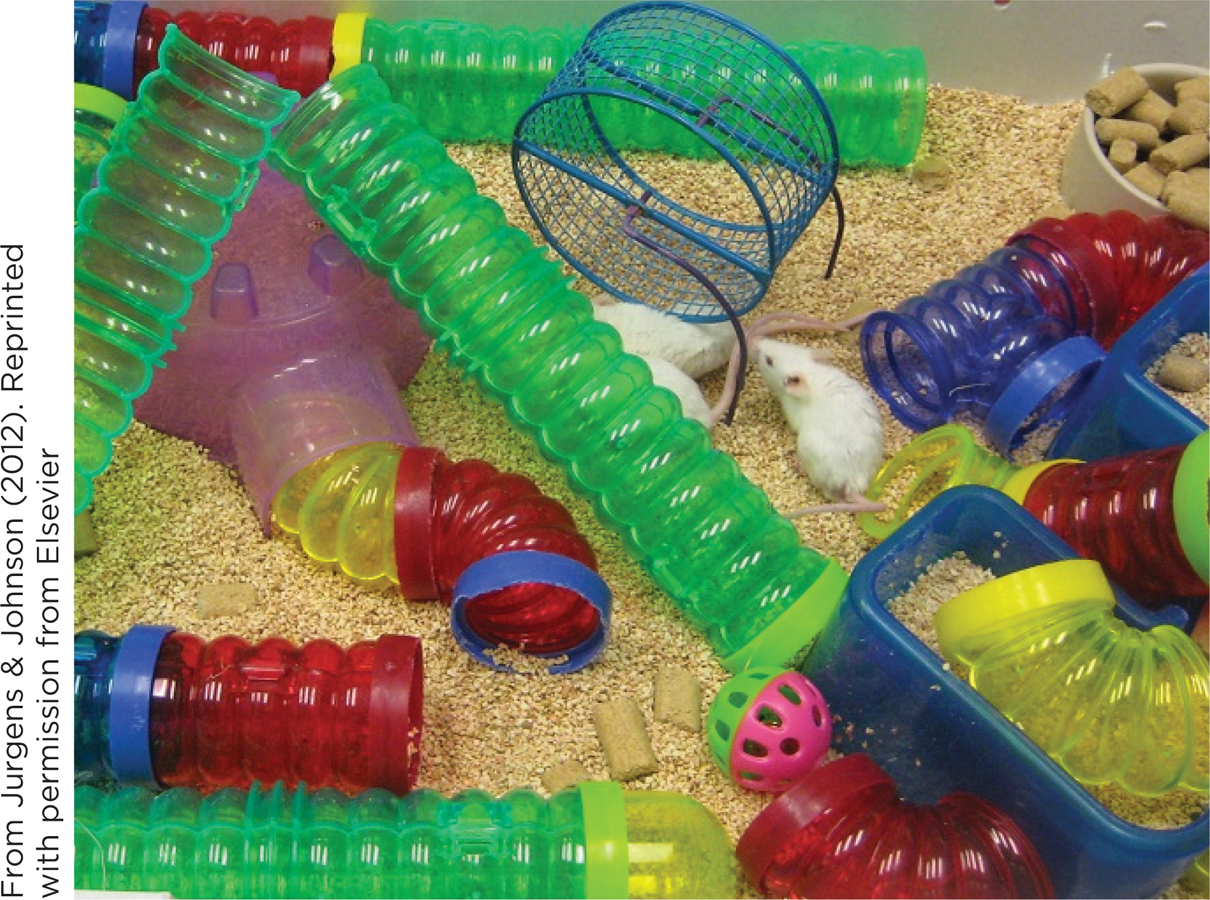
These results demonstrate a key fact about the brain (also see Chapter 3). The exact structure of the brain, for any organism, is a product of both inheritance and experience. Just as physical exercise builds stronger muscles, the mental exercise that occurs in enriched environments builds a stronger brain.
THE DEVELOPMENT OF SUBSYSTEMS OF THE BRAIN. Another psychological fact suggests another prediction about brain development. Psychologically, as you learned, children experience a sequence of stages; at one stage they cannot perform tasks that, at a later stage, are easy for them. This suggests that the brain should develop through a sequence of stages, too.
It does. “In general, the sequence in which the cortex matures parallels cognitive milestones in human development” (Casey et al., 2005, p. 104). To understand the brain’s maturation, you have to recall that the brain contains different parts that specialize in different tasks (e.g., understanding language, processing visual images, generating emotions, thinking about oneself). It turns out that these different parts develop in a fixed sequence. Consider three regions of the brain: (1) sensorimotor cortex (involved in basic perceptual processes and motor movement), (2) parietal and temporal cortices (whose many functions include language processing), and (3) prefrontal cortex (critical to sustaining attention on tasks and controlling emotional impulses). Brain research indicates that (Casey et al., 2005; Figure 14.5):
The sensorimotor cortex matures first, with rapid development occurring in the first months of life.
The parietal and temporal cortices develop later, with major biological development occurring between ages 8 months and 2 years.
615
The prefrontal cortex evolves last, with this region of brain not reaching substantial maturity until well into the teenage years, and with final refinements of neural structure still occurring in a person’s 20s (Johnson, Blum, & Giedd, 2009).
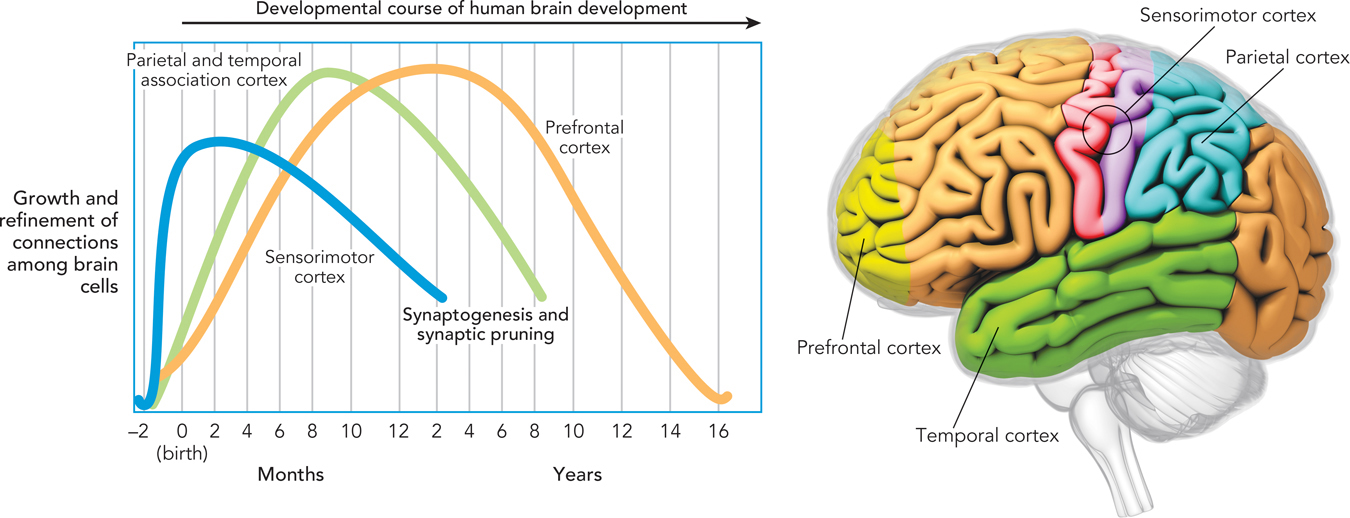
No wonder Piaget discovered a sensorimotor stage at which children can think, but not in words. At this Piagetian stage, children’s sensorimotor cortex is developed, but language-
THE DEVELOPMENT OF BRAIN NETWORKS. The brain’s specialized parts are interconnected. Nerve cells link distinct neural systems, creating information networks within the brain (Sporns, 2010). When people engage in complex mental activities, such as solving a problem, multiple interconnected regions of their brains are active (Gerlach et al., 2011).
A major feature of brain development is that, over time, these networks change (Fair et al., 2009). In childhood, most of the brain’s connections are “local”; that is, they interconnect neurons within one region of the brain. Later in life, connections become “global”; different regions of the brain become more strongly interconnected (Khundrakpam et al., 2013).
Advances in brain imaging let us see these interconnections. Researchers obtained brain images in two groups of people: children aged 7 to 9 and adults aged 19 to 22 (Uddin et al., 2011). They focused on connections between two regions of the brain:
The brain’s central executive system (shown in green in Figure 14.6): The central executive system enables people to manipulate information in their minds, develop strategies, and make decisions in order to achieve their goals.
 figure 14.6 It’s all about communication Compared to a child’s brain, the different regions of an adult’s brain are better able to communicate with each other, thanks to the development of cellular connections that link one brain region to another. Shown are two regions in the front of the brain that are involved in paying attention to information in the environment (lavender) and maintaining, in mind, information about personal goals (green). Also shown, in yellow, are nerve fibers that connect the two regions. The connections are stronger in adulthood than in childhood.
figure 14.6 It’s all about communication Compared to a child’s brain, the different regions of an adult’s brain are better able to communicate with each other, thanks to the development of cellular connections that link one brain region to another. Shown are two regions in the front of the brain that are involved in paying attention to information in the environment (lavender) and maintaining, in mind, information about personal goals (green). Also shown, in yellow, are nerve fibers that connect the two regions. The connections are stronger in adulthood than in childhood.616
An attentional network (shown in lavender in the figure): specifically, a brain region used to pay attention to multiple external events and internal signals (hunger, pain, etc.) and to focus attention on those that are most important to well-
being at any given time (Seeley et al., 2007).
As you can see in Figure 14.6, the two brain regions do not change significantly from childhood to adulthood. But the interconnections between them do (Uddin et al., 2011). The connections are stronger—
What is the psychological implication of this biological finding? The brain connections enable people to gain greater control over their thoughts, emotions, and behavior (Menon & Uddin, 2010). Early in life, when the connections are weak, children may respond in a quick, reflexive manner to environmental events that grab their attention. For example, a child who is supposed to be doing homework might become distracted by a toy or by even slight feelings of hunger. Later in life, people are better at controlling what they pay attention to and concentrating on problems to be solved. This greater control is due, in part, to the stronger connections between the brain’s central executive and attentional networks.
In sum, brain research deepens our understanding of cognitive development. As children age and interact with the world, their growing cognitive abilities are accompanied by growth in the biological systems of the brain (Figure 14.7).


Cognitive abilities are not the only aspects of life that change with development. People also develop emotions and motivation, the ability to control their emotions and behavior, and a sense of self—
617
618
WHAT DO YOU KNOW?…
Question 7
Which of the following findings are consistent with the prediction that environmental experiences should spur biological development in the brain?
- LvnXV8Y6+/8vfTMPSi2pM0ECWxxvhsDGQpNWhE6aSJwPMJMV50sBfle1ZHEbeFq3WGZcA4kuInocQ0qfflkx12cFX2DlGrU1Le4o5/PKD0ehs3aVEQGQZdmyXGfIu3qT/Dv87fEfbpH7XHJgzuRKfm6/MDTvsmCr6BENwywYmX6ynF2Qurcs2r5L5uvu8EvJR5h+LBiG+nSLUjhiKvDttcrbj8Djass5GGq74UCPGG8MtW2mt6JH9cwvOKlq0fDWl2nsfd6fCwdgGUZeJzWtG8M6BBRuHnwPnHKZDCdtf0wtzo5BfLc6fg==
- k6W65Q7faosT6myPUcRoEUU26/cTV7ANt48UiLEM3Qh1W2TgMo9F/EKkd8j2wy0N0rrigSSEnMuL9Zg2rOBEPrz5wMZOLgHIE9FLUf5ducosRsJ+M3ZyDl+PInpL7qOiL7sEuEQFq9a9Uj9pJSMCq6HVWohHxByj8AkbfA3PcWDkv6ic6r0HSfEDIbv2JZ7NmbLABMkyfGc/Ro8WuT+1enQO5G65qrH3X9mExDknD98=
- w2RLTHyVEDFj0+brJK9eGETDOF4W5H78HbmDzuDeQFu8CUrI4c94EAzQmz0akKMWX6Cn+ZqUi6aLmb0EmU86oRa6bwISfXTdX4rrQqXpPcKS8oypzFsdYRJl8TT+jXEJXnMQRewYDlefcjGbWPTMJUW1Fop6oEX/P//Uk6N4KrqEuwfBd6ogC9oahJJSXGJSoRdLwQ==